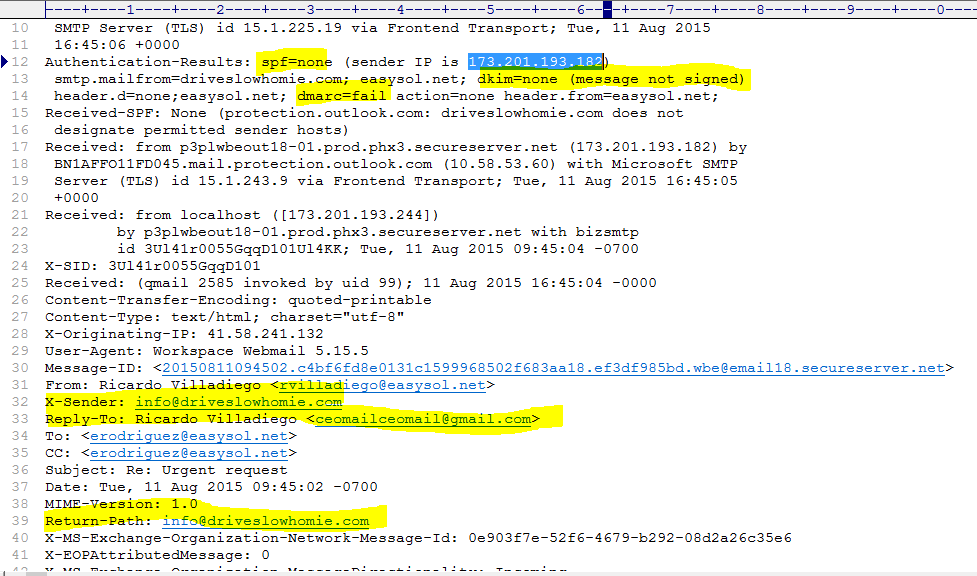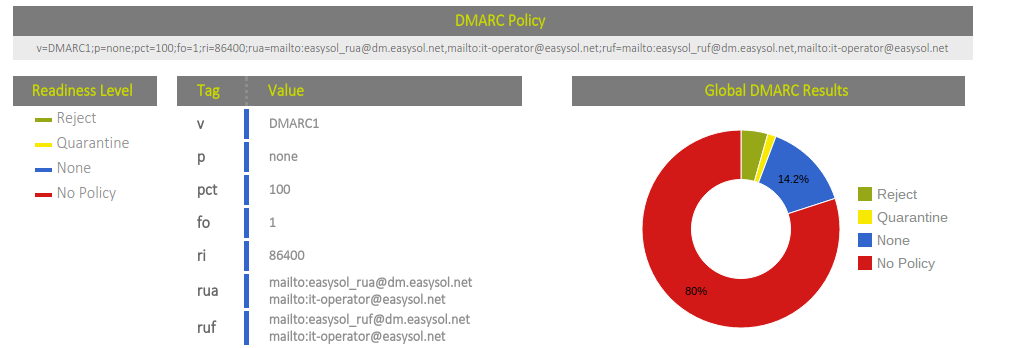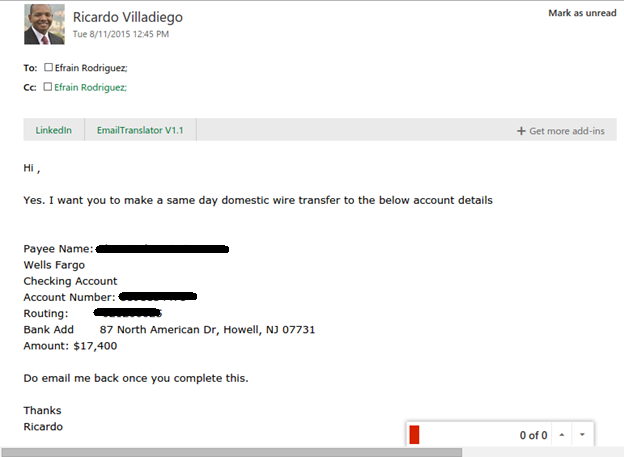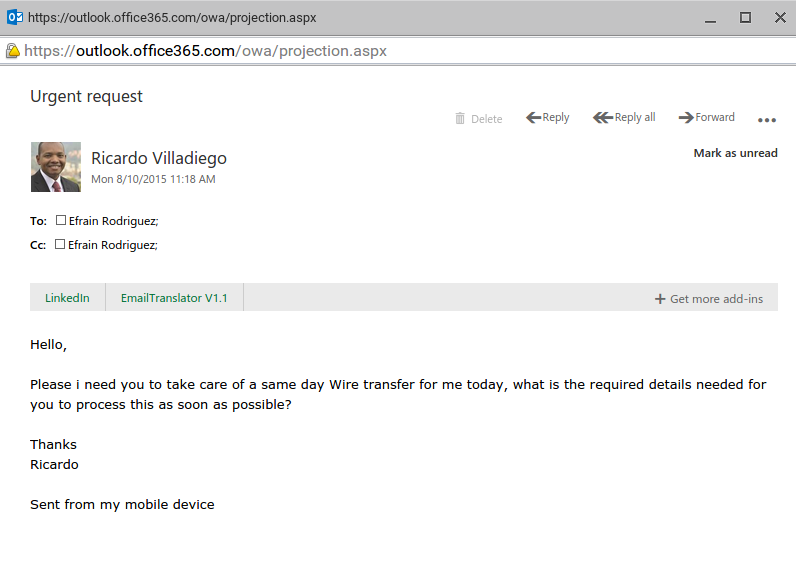Being at the forefront of fraud prevention, our level of awareness for fraud related schemes is definitively higher than it is for any other business. We live to fight back fraud 24 by 7, and being one of the pioneers in the industry to champion DMARC and knowing its benefits.
we decided to deploy the DMARC policy in monitoring mode, as you can see here :
P=none means no action is taken on emails that fail the authentication protocol, however, we have the visibility as to who is spoofing our domain and for what purpose.
Knowing that it was a matter of time until criminals attempted a move against our organization, we started our monitoring process. And it was last week when I received a call from the CFO, who was properly trained to identify suspicious emails, to validate if an email requesting a wire transfer was sent legitimately.
While you never want to be the attempted victim of fraud, part of me was happy this happened, because I’ve been thinking about this post for some time.
Below you see the screenshot with the spoofed email.
One note to make here is that most likely the recipient’s account was also compromised, so we immediately notified the financial institution so they can conduct their investigation.
A common technique, employed here is to follow-up with additional emails to increase the pressure:
 Looking at the DMARC record, you can see that as a result of our published DMARC policy, these emails failed the email authentication protocol, and they would have been stopped if our policy was set to P=Reject.
Looking at the DMARC record, you can see that as a result of our published DMARC policy, these emails failed the email authentication protocol, and they would have been stopped if our policy was set to P=Reject.
 We were not hit by this scam because our team is well trained to know what to look for and we have deployed DMARC technology to help us identify and block spoofed messages. However, the consequences of an attack like this are infinite. Imagine this wire actually taking place, or a request for a new email account and privileged credentials being assigned to the wrong party, or confidential information being shared. Spear-phishing can come in many forms, but the formula is always the same.
We were not hit by this scam because our team is well trained to know what to look for and we have deployed DMARC technology to help us identify and block spoofed messages. However, the consequences of an attack like this are infinite. Imagine this wire actually taking place, or a request for a new email account and privileged credentials being assigned to the wrong party, or confidential information being shared. Spear-phishing can come in many forms, but the formula is always the same.
These attacks exist because it is still possible to easily and cheaply forge emails from any address on the Internet as outlined by FS-ISAC/CERT. The alternative attack vector for these kinds of attacks is to directly compromise the sender’s email account via malware or some other method of compromise. This method, while possible it is harder and more expensive for the attacker. We believe that steps must always be taken to push costs to adversaries and never present them with an easy and cheap option.
What to Do?
- Deploy DMARC to gain visibility into email attacks and spear-phishing both targeting your employees and your clients
- Consider leveraging a DMARC visibility and compliance product such as DMARC Compass
- Confirm with your enterprise email team that your email enterprise email provider honors DMARC policies on inbound email to prevent spear-phishing attacks.
- Train your leadership, especially in finance about the risks associated with these kinds of attacks, methods of detection and manual authentication.
This is just another real-world example of the all-to-common attacks that are putting many enterprises at risk. We strongly encourage any enterprise that relies on trusted email-based communication with their clients to evaluate these recommendations to see if they work for you. Also, even if you have no plans currently to leverage DMARC to block spoofed email, it is very important to leverage the power of DMARC to gain visibility into real or potential attacks that might lead directly to successful attacks.
We are the living proof that it is a matter of time until criminals threaten your business. These attacks are inexpensive and easy to launch, as such, they will continue to happen until organizations improve their email authentication methods, making it harder for cybercriminals to carry on their fraudulent operations.[su_box title=”Ricardo Villadiego, CEO of Easy Solutions” style=”noise” box_color=”#336588″] After more than a decade in the IT security sector, Ricardo Villadiego decided to take a risk and start a security company of his own. The result is Easy Solutions, a state-of-the-art and creative business that is a reflection of the man who runs it. Ricardo sought to build a company with a highly-motivated group of engineers free to unleash their imaginations and think up fresh and original solutions to confront the constantly evolving threat landscape of the internet. Flexible and agile, the Easy Solutions team can adapt, change course, and most importantly take care of any electronic security problem quickly. This hardworking team, affectionately dubbed the “Easy Solvers”, follow in their leader’s easygoing but results-oriented footsteps, working their tails off but always leaving some time to relax and bust some dance moves or play a quick game of soccer.[/su_box]
After more than a decade in the IT security sector, Ricardo Villadiego decided to take a risk and start a security company of his own. The result is Easy Solutions, a state-of-the-art and creative business that is a reflection of the man who runs it. Ricardo sought to build a company with a highly-motivated group of engineers free to unleash their imaginations and think up fresh and original solutions to confront the constantly evolving threat landscape of the internet. Flexible and agile, the Easy Solutions team can adapt, change course, and most importantly take care of any electronic security problem quickly. This hardworking team, affectionately dubbed the “Easy Solvers”, follow in their leader’s easygoing but results-oriented footsteps, working their tails off but always leaving some time to relax and bust some dance moves or play a quick game of soccer.[/su_box]
The opinions expressed in this post belongs to the individual contributors and do not necessarily reflect the views of Information Security Buzz.






